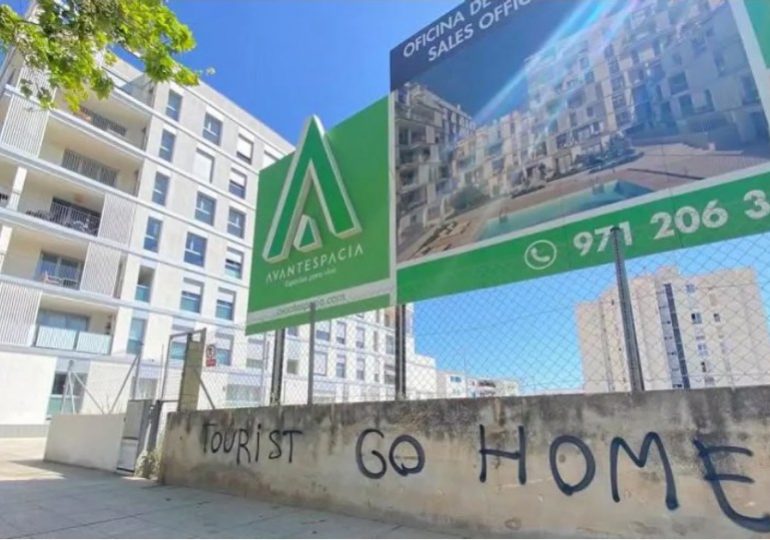BRITS have been told to “go home” in another holiday hotspot as more anti-tourist graffiti has been sprayed across the streets of Spain.
Majorca now follows the Canary Islands in a wave of furious locals calling for ‘low-quality’ tourists to stop flocking down to the Spanish paradises.
Miguel VicensAnti-tourist graffiti appeared underneath a real estate promotion billboard in Nou Llevant, Majorca[/caption]
A growing anti-tourist movement has swept the islands in recent months
APAnti-tourist protesters held up banners reading ‘People live here’ and ‘We don’t want to see our island die’[/caption]
EPAA graffiti against tourists is seen at the Guell Park in Barcelona, Spain[/caption]
The latest ‘tourist-phobic’ graffiti appeared in a Majorcan neighbourhood which has seen a massive influx of foreign buyers over the years.
The words ‘Go Home Tourist’ were scrawled in English over a wall underneath a real estate promotion billboard in Nou Llevant, where most homes were snapped up by Germans.
As no-one has yet claimed responsibility for the graffiti, overnight pictures were published by local press, less than a month after similar messages appeared in southern Tenerife.
Island newspaper Diario de Mallorca described it as the first example of tourism-phobia in Nou Llevant, and said it was targeted at the neighbourhood’s “new foreign residents.”
Majorcan locals have now been echoing similar complaints protesters in the Canary Islands have been making.
One woman interviewed previously told local media it was difficult to communicate with neighbours because most only spoke German and the majority of apartments where she lived were being purchased as holiday homes or rental investment properties.
Residents in the Balearic Islands – which include Majorca and Ibiza -showed their support for the Canary Islands protesters, who took to the streets in their thousands on Saturday.
Organisers in Tenerife said 80,000 people joined the protests under the slogan: “The Canary Islands have a limit.”
Official estimates put the number of people at around 30,000.
Canarias Se Agota, the lead platform behind the Canary Islands protests, has voiced demands which include a halt to two controversial hotel projects, an eco-tax and more sustainable tourism.
Anti-tourist graffiti has been popping up across Tenerife
GettyUp to 50,000 people are believed to have attended the march in Tenerife[/caption]
Residents in the Canary Islands say British visitors just come for the cheap beer, burgers, and sunbathing
Protests took place in Tenerife, Gran Canaria, Lanzarote, Madrid and Malaga
Some British holidaymakers have shown their support for the issues raised by the islanders but others have accused them of biting the hand that feeds them.
Six men and women affiliated to Canarias Se Agota, which in English would translate as ‘Canary Islands on the Brink,’ are now on day 12 of “indefinite” hunger strike outside a church in the town of La Laguna in northern Tenerife.
They were filmed being bought to the Saturday protest in the Tenerife capital Santa Cruz in wheelchairs.
Campaigners were quick to distance themselves from anti-tourist graffiti which appeared on walls and benches in and around Palm Mar in southern Tenerife at the start of the month.
Messages in English left on walls and benches in and around the resort read ‘My misery your paradise’ and ‘Average salary in Canary Islands is 1,200 euros.’
In an apparent UK backlash, a response left in English on a wall next to a ‘Tourists go home’ message said: “F*** off, we pay your wages.”
At the beginning of last week a picture was also published in local press showing the words ‘Go Home’ on a hire car in Tenerife.
Tourist Tax
Brits could now face a daily ‘tourist tax’ to visit the Canary Islands after anti-tourist protestors demanded a freeze on holidaymakers.
As tens of thousands of angry residents took to the streets to rage against the industry, President of the Canary Islands, Fernando Clavijo, warned that a daily cost for visitors could be on the table.
While not included in current plans, Clavijo said the government is willing to look at suggestions of a three euro per night charge.
He said last Friday: “It is true that the ecotax is not included in the government program, but it is also true that we are willing to discuss it; the government will always engage in dialogue.”
Tourists visiting the equally popular Balearic islands – including Majorca, Minorca and Ibiza – already pay between one and four euro per day if over 16.
The Canary Islands president has previously begged Brits to visit the holiday hotspot after furious locals branded them “low-quality”.
Residents have labelled UK tourists as a “cancer” as prices skyrocket and they allege intoxicated partygoers are destroying their paradise.
President Clavijo said that some of the ideas stated by activists “smack of tourist-phobia”.
AlamyThousands of holidaymakers flock to the Canary Islands every summer[/caption]
AlamyBrit tourists were labelled ‘low-quality’ by locals as they overcrowd beaches[/caption]
COVER LANZAROTEAn unofficial sign in Lanzarote reads ‘Do Not Enter: This area is closed for tourist overcrowding’[/caption]
Canarian WeeklyFed-up locals claim their island is ‘collapsing socially and environmentally’[/caption]
“People who come here to visit and spend their money must not be criticised or insulted. We are playing with our main source of income,” he said.
Tenerife residents have been fuming that they are “fed-up” with “low-quality” British visitors who just come for the cheap beer, burgers, and sunbathing.
As well as a tourist fee, they are seeking fewer flights to the island, and restrictions on foreigners owning homes.
Locals also allege that AirBnbs and other vacation rentals are raising the cost of living, and they are tired of the noise, traffic, and trash that accompany the influx of holidaymakers that arrive each year.
‘Too many people’
Meanwhile, the son of a famous Brit poet and author said his dad wouldn’t have set foot in the famous Majorcan village he’s buried because it’s too overcrowded.
Robert Graves’ son, William, said Deia nowadays has “too many people and two many cars”.
His father, who produced more than 140 works in his lifetime, spent most of his life in Deia before it became the millionaire’s hideaway it is today.
Graves, whose house opened to the public in the summer of 2006 after being refurbished and adapted, is buried under a cypress tree in the village churchyard.
The author and poet died of heart failure aged 90 in December 1985 at his home in Deia.
But the man credited with putting Deia on the map wouldn’t be a fan of the modern-day version, his son told island newspaper Diario de Mallorca.
The village has a tiny rocky cove beach surrounded by the beautiful Tramuntana mountains which gets packed in summer with throngs of tourists and day trippers.
William, who moved to Deia with his dad as a five-year-old and in 1995 wrote a memoir recalling the magic of his childhood there, said the village “relaxed” his father when he returned from conferences abroad.
But when asked whether Robert would move to the village today if he was still alive, his son said: “No, frankly.
“He wouldn’t go because there are too many people and too many cars.”
“The tranquility of Deia is only conserved in luxury hotels like La Residencia and Es Moli.”
Asked whether his father “created the magic of Deia”, the famous poet’s son appeared to align himself with some of the issues which sparked the huge demonstrations in the Canary Islands by saying:
“My father came to an unspoilt place and left his mark on Deia, but he didn’t create the reddish sunsets of the Teix mountain, that magic that has long gone, that vanished.
“The Tramuntana mountains are still there, but too overloaded.”
Geologist William, Graves’ first son with his second wife Beryl Pritchard Hodge, is his literary executor.
He translated his father’s influential book ‘The White Goddess’ into Spanish.
William received an MBE in 2021 for services to British culture and literature in Spain.
TOURIST TRAP
A RISING number of visitors in idyllic holiday hotspots is forcing out locals.
Important amenities such as post offices and village shops are being disposed of to make way for more houses and cafes for tourists.
Locals are also struggling to climb on the property ladder as many houses sit empty, being used as second homes and holiday lets.
In some hotspots this has created a major housing crisis as demand for accommodation and second homes drives house prices sky high.
Road infrastructure and parking systems often can’t cope with more tourists – leading to traffic chaos and safety concerns.
The issues see younger families leaving the area, in turn making it harder for community members left behind.









